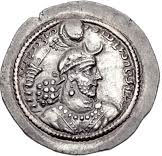Yazdegerd

Yazdegerd I, the Sassanian king
When the Sassanian king Bahram IV was killed in 399 AD, his brother Yazdegerd took control of the Sassanian empire. Yazdegerd maintained peace with the Roman Empire under Empress Pulcheria, not attacking the Romans even though they had been weakened by Vandal, Visigothic and Ostrogothic invasions. He didn’t attack any of his neighbors in the east either: a peaceful dude.
Who is this Pulcheria?
Yazdegerd didn’t persecute anyone for their religion: he was friendly to Christians, Manichaeans, and Jewish people (and perhaps Buddhists?). Later in his reign, though, he leaned more towards Zoroastrianism, and there were some Christian persecutions. Yazdegerd kept his throne for twenty years, dying in 420 AD. (Nobody knows whether he was killed or just died.)
More about Zoroastrianism
Bahram V
Yazdegerd’s sons and their cousins had a civil war over who would rule when he died, using Arab mercenaries to fight their battles. (Both Sassanians and Romans were using Arab mercenaries more and more.) In the end, it was Yazdegerd’s son Bahram V who got power.
Bahram V was able to use the power of the Zoroastrian priests to back him up against the rich powerful families; in exchange, he persecuted the Christians. His Christian persecution made Pulcheria mad, and she sent a Roman army to Armenia. Again, both sides used Arab mercenaries. Bahram fought back, and the two sides agreed to go back to their borders before the war, but with less religious persecution. By that time, the White Huns were invading in the east, so Bahram went and fought them off too – or paid them to leave him alone.
Why are the White Huns invading?
Yazdegerd II
Bahram died in 438, and his son Yazdegerd II took over the Sassanian Empire. Yazdegerd II immediately abandoned his father and grandfather’s peaceful policies, and attacked Pulcheria’s Roman Empire in 440 AD. He also went back to trying to force Christians and Jews to convert to Zoroastrianism.
Pulcheria, already busy with Vandal and Hun attacks, paid Yazdegerd off to leave her alone. Yazdegerd moved north and took control of Armenia, and then used that as a base to defend the Sassanian Empire against the White Huns in the 450s.
Denag and her sons Peroz and Kavadh

A gold coin of Kavadh I, the Sassanian king who worked with Mazdak
When Yazdegerd II died (or was killed) in 457 AD, his wife, Denag, ruled the empire while their sons fought a short civil war. By 459 the White Huns stepped in and helped the younger son, Peroz, win and get power. So he owed them a favor, and he gave them some of his eastern land in what is now Afghanistan.
This set the pattern for the future: Peroz was too weak to win anything, so he was always paying his enemies off in money or land, borrowing money from one neighbor to pay off another, or sending hostages – even his own children – to his enemies as security for peace.
A severe drought between 464 and 471 made things worse. The Sassanian Empire, like the Roman Empire at the same time, was slowly crumbling.
When Peroz died in an ambush in 484, his remaining brothers fought another civil war, and again the White Huns decided who would win: Kavadh. Kavadh started out with a problem: powerful rich families and the Zoroastrian priests had most of the power, and he didn’t have much. Soon after he got into power, Georgia, Armenia, and other provinces declared their independence. Wars with the Byzantine emperor Anastasius over who would collect taxes from the rich farmland of western Iraq and Syria alternated with Roman demands for money to pay tribute to the Huns.
More about Anastasius
Mazdakites
About 500 AD, a new Zoroastrian prophet appeared in Iran, whose name was Mazdak. Mazdak wanted to redistribute the land and money and do away with the religious ceremonies and privileges of Zoroastrianism.
More about Mazdak
This was popular and got a lot of followers. Kavadh saw that he could use the Mazdakites to break the power of the rich families and the Zoroastrian priests, so he supported the Mazdakite movement. But by 520, the rich families and priests fought back, and Kavadh got scared. He and his son, Khosrau, killed Mazdak and many of his followers, and cut back on the reforms. But they kept the tax reform, which began a new period with more power for the Sassanian rulers.
After a long reign, Kavadh died in 531, and there was another civil war among his sons and grandsons.
Sassanian kings and queens in the 500s AD
Sassanian Empire
Iran under the Islamic Empire
Bibliography and further reading about the Sassanians:
Ancient Persia, by Don Nardo (2003). For kids, good for reports.
Parthian Art, by Malcolm Colledge (1977). Not very easy to get anymore, but it’s the classic book for the Parthians – it has a lot more than just the art.
Ancient Persia, by Josef Wiesehofer (2001). Includes the Parthians and the Sassanians.
Sasanian Society: Warriors, Scribes, Dehqans, by A. Tafazzoli (2000). An Iranian perspective.
The Cambridge History of Iran: Volume 3, The Seleucid, Parthian and Sasanid Periods, Part 2: Seleucid Parthian, edited by E. Yarshater (reprinted 1983). Expensive but complete.